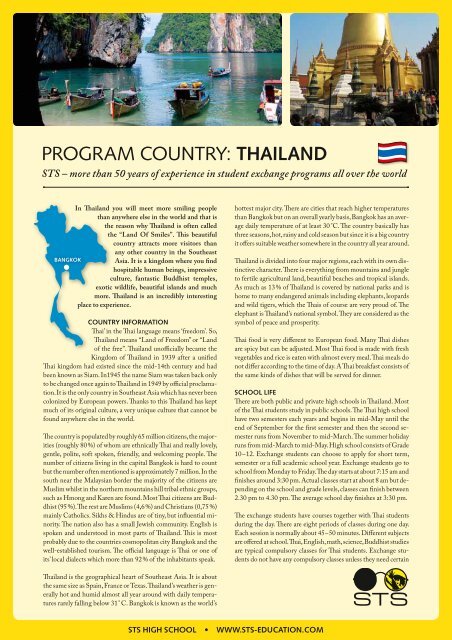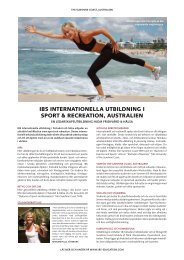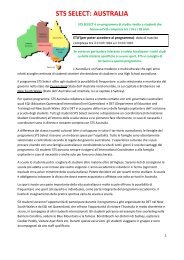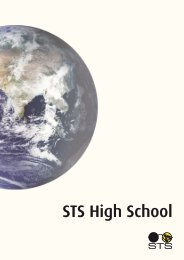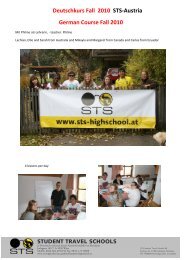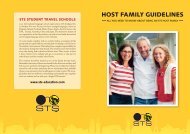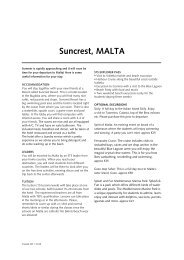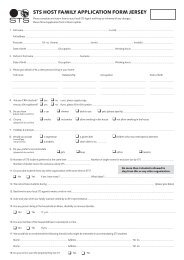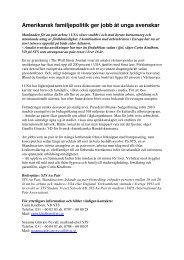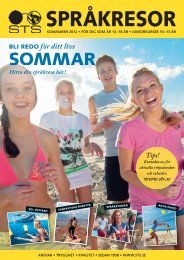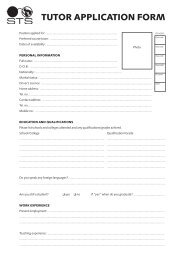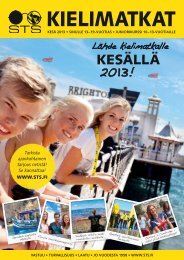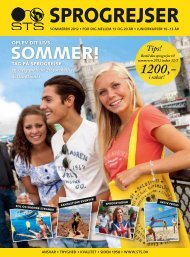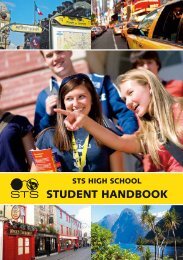Create successful ePaper yourself
Turn your PDF publications into a flip-book with our unique Google optimized e-Paper software.
<strong>PROGRAM</strong> <strong>COUNTRY</strong>: <strong>THaILand</strong><br />
<strong>STS</strong> – more than 50 years of experience in student exchange programs all over the world<br />
In Thailand you will meet more smiling people<br />
than anywhere else in the world and that is<br />
the reason why Thailand is often called<br />
the “Land Of Smiles”. This beautiful<br />
country attracts more visitors than<br />
any other country in the Southeast<br />
BanGkOk<br />
Asia. It is a kingdom where you find<br />
hospi table human beings, impressive<br />
culture, fantastic Buddhist temples,<br />
exotic wildlife, beautiful islands and much<br />
more. Thailand is an incredibly interesting<br />
place to experience.<br />
COunTry InfOrmaTIOn<br />
Thai’ in the Thai language means ‘freedom’. So,<br />
Thailand means “Land of Freedom” or “Land<br />
of the free”. Thailand unofficially became the<br />
Kingdom of Thailand in 1939 after a unified<br />
Thai kingdom had existed since the mid-14th century and had<br />
been known as Siam. In1945 the name Siam was taken back only<br />
to be changed once again to Thailand in 1949 by official proclamation.<br />
It is the only country in Southeast Asia which has never been<br />
colonized by European powers. Thanks to this Thailand has kept<br />
much of its original culture, a very unique culture that cannot be<br />
found anywhere else in the world.<br />
The country is populated by roughly 65 million citizens, the majorities<br />
(roughly 80 %) of whom are ethnically Thai and really lovely,<br />
gentle, polite, soft spoken, friendly, and welcoming people. The<br />
number of citizens living in the capital Bangkok is hard to count<br />
but the number often mentioned is approximately 7 million. In the<br />
south near the Malaysian border the majority of the citizens are<br />
Muslim whilst in the northern mountains hill tribal ethnic groups,<br />
such as Hmong and Karen are found. Most Thai citizens are Buddhist<br />
(95 %). The rest are Muslims (4,6 %) and Christians (0,75 %)<br />
mainly Catholics. Sikhs & Hindus are of tiny, but influential minority.<br />
The nation also has a small Jewish community. English is<br />
spoken and understood in most parts of Thailand. This is most<br />
probably due to the countries cosmopolitan city Bangkok and the<br />
well-established tourism. The official language is Thai or one of<br />
its’ local dialects which more than 92 % of the inhabitants speak.<br />
Thailand is the geographical heart of Southeast Asia. It is about<br />
the same size as Spain, France or Texas. Thailand’s weather is generally<br />
hot and humid almost all year around with daily temperatures<br />
rarely falling below 31 ° C. Bangkok is known as the world’s<br />
hottest major city. There are cities that reach higher temperatures<br />
than Bangkok but on an overall yearly basis, Bangkok has an average<br />
daily temperature of at least 30 °C. The country basically has<br />
three seasons, hot, rainy and cold season but since it is a big country<br />
it offers suitable weather somewhere in the country all year around.<br />
Thailand is divided into four major regions, each with its own distinctive<br />
character. There is everything from mountains and jungle<br />
to fertile agricultural land, beautiful beaches and tropical islands.<br />
As much as 13 % of Thailand is covered by national parks and is<br />
home to many endangered animals including elephants, leopards<br />
and wild tigers, which the Thais of course are very proud of. The<br />
elephant is Thailand’s national symbol. They are considered as the<br />
symbol of peace and prosperity.<br />
Thai food is very different to European food. Many Thai dishes<br />
are spicy but can be adjusted. Most Thai food is made with fresh<br />
vegetables and rice is eaten with almost every meal. Thai meals do<br />
not differ according to the time of day. A Thai breakfast consists of<br />
the same kinds of dishes that will be served for dinner.<br />
SCHOOL LIfe<br />
There are both public and private high schools in Thailand. Most<br />
of the Thai students study in public schools. The Thai high school<br />
have two semesters each years and begins in mid-May until the<br />
end of September for the first semester and then the second semester<br />
runs from November to mid-March. The summer holiday<br />
runs from mid-March to mid-May. High school consists of Grade<br />
10–12. Exchange students can choose to apply for short term,<br />
semester or a full academic school year. Exchange students go to<br />
school from Monday to Friday. The day starts at about 7:15 am and<br />
finishes around 3:30 pm. Actual classes start at about 8 am but depending<br />
on the school and grade levels, classes can finish between<br />
2.30 pm to 4.30 pm. The average school day finishes at 3:30 pm.<br />
The exchange students have courses together with Thai students<br />
during the day. There are eight periods of classes during one day.<br />
Each session is normally about 45–50 minutes. Different subjects<br />
are offered at school. Thai, English, math, science, Buddhist studies<br />
are typical compulsory classes for Thai students. Exchange students<br />
do not have any compulsory classes unless they need certain<br />
<strong>STS</strong> HIGH SCHOOL • www.<strong>STS</strong>-eduCaTIOn.COm
<strong>PROGRAM</strong> <strong>COUNTRY</strong>: <strong>THaILand</strong><br />
subjects for their transcription for when they return to their home<br />
countries. Computer studies, health education, physical education,<br />
classical Thai music, Thai dance, Thai crafts, Thai illustration, Thai<br />
painting, Thai cooking etc. are examples of elective subjects. Sports<br />
are always offered at the schools. Some schools offer more sports<br />
than others but there are always ways for students to play sports<br />
they like. There is football, volleyball, badminton, swimming, basketball,<br />
handball, hockey, judo, tae kwan do, track & field and<br />
tennis. To take part in a sport is a great opportunity for exchange<br />
students to make new friends. In most cases, exchange students<br />
take extra Thai courses to improve their Thai proficiency. Students<br />
are encouraged to talk freely about a variety of topics about real life<br />
situations and all aspects of Thai culture and modern society. Additional<br />
practice of word usages and sentence drills and other helpful<br />
class activities are organized. Thai schools teach both English and<br />
Thai languages which have various activities to help students to<br />
learn. From the beginner level to advanced level, students will fully<br />
develop their Thai speaking, listening, reading and writing skills.<br />
All Thai schools have uniforms codes and strict grooming standard.<br />
There are also school rules regarding jewelry, length of skirts and<br />
dresses etc. There are many shops that sell school uniforms and the<br />
host families will take the students to get their uniforms. In Thai<br />
schools students must look neat and tidy. The boys for example<br />
must have their shirts tucked neatly into their trousers and cannot<br />
have long hair. Girls cannot wear skirts too short and are limited<br />
in how much jewelry they can wear. All Thai schools have canteens<br />
that sell freshly cooked food. Students always have lunch at school<br />
and it is really cheap. Students will call their teachers by their first<br />
name but with the Thai word for ‘teacher’ or ‘professor’ in front of<br />
the first name. The Thai word for ‘teacher’ is ‘ajarn’. If for example the<br />
teacher’s name is Sompon, the student will call him, ‘Ajarn Sompon’.<br />
Just like, ‘teacher Sompon’. However the student can also call the<br />
teacher ‘Mr Sompon’ or Ms. Jirapat’. Thai teachers will consider<br />
this a polite way to be addressed. But the exchange students would<br />
be better off using the Thai version as they should be learning as<br />
much Thai as possible and getting used to using Thai whenever possible.<br />
Thai teachers are expected to know some English. We highly<br />
encourage exchange students to communicate in Thai, which will<br />
improve their Thai proficiency quickly. In each school we have one<br />
teacher who will take care of our inbound students. The student<br />
can discuss all subjects with them. We also have a teacher who can<br />
always advise any of the exchange students if they need to talk.<br />
HOST famILy LIfe<br />
The host families are carefully selected. The area representatives are<br />
required to visit the host families personally to discuss each host<br />
family’s expectations and prepare them for the responsibilities of<br />
a successful hosting experience. Through the whole year, the area<br />
representatives will keep in close contact with the host families<br />
and the students, to ensure that every students are encouraged to<br />
introduce food from their own cultures too. Apart from knives<br />
and forks, the students will experience using a spoon and fork and<br />
occasionally chopsticks in Thailand. Thais use a spoon and fork to<br />
eat almost all daily meals. Western style cuisine, snack foods etc.<br />
are becoming more and more popular in Thailand. Students therefore<br />
still have the chance to have Western food when they miss it.<br />
During the year, students will celebrate the Thai holidays with the<br />
host family, such as Song Kran Festival to celebrate the Thai New<br />
Year in April, Loi Kratong Festival to honor the Buddha which<br />
involves floating ‘Gratong’, (an ornate offering traditionally made<br />
from banana leaves, lotus leaves and lotus flowers, incense sticks<br />
and candles that people will release onto rivers, canals and lakes<br />
all across Thailand and Laos.) Loi Kratong festival takes place on<br />
the evening of a full moon in November. Another important holiday<br />
is the King’s Birthday on December 5 which is also Father’s<br />
Day. Thais also observe the New Year celebrations according to the<br />
western calendar on December 31. Holidays are a time for family<br />
reunions, sitting together with loved ones, setting off firecrackers<br />
and watching traditional entertainment such as classical Thai dancing<br />
known as ‘Lumm Thai’. Manners and etiquette between adults,<br />
the elderly and the young are very important In Thai culture. It is<br />
polite, common practice to address your elders as ‘older brother/<br />
older sister’, ‘grandfather/grandmother’ etc. even when you are not<br />
related and even if you do not know the person. On the whole,<br />
young Thai people are polite, respectful, friendly, very easy going<br />
and accepting. Young Thai people are taught to respect their elders.<br />
PrOGram exTraS<br />
There are many interesting places worth visiting in Thailand. During<br />
the exchange year the students will have the opportunity to visit<br />
many interesting places either together with their host family or/<br />
and with other exchange students and area representatives. Thais<br />
are wonderful hosts and love to show international visitors around.<br />
Most of the host families love to travel and they will take their<br />
exchange sons or daughters along with them. Northern Thailand<br />
has mountains, forests, ethnic hill tribes etc. It borders Burma and<br />
Laos. The north east has very little foreign tourists compared to<br />
other parts of Thailand and is mainly a rural area. Central Thailand<br />
has a lot of rice fields, forests, national parks etc. The east borders<br />
Laos and Cambodia and is a very interesting place and a great way<br />
to see an authentic side of Thai rural culture without the normal<br />
tourist traps. The southwest and southeast have coastlines, beautiful<br />
tropical islands that offer great scuba diving. There are islands in<br />
the Gulf of Thailand, on both the east and west mainland coasts<br />
and also the Andaman Sea along the southwest of Thailand. The<br />
far south of Thailand borders Malaysia. Bangkok itself is a very<br />
large city with many interesting things to see and do. Bangkok is<br />
a mixture of old traditional Thailand and also a fusion of Thai and<br />
western cultures. It just depends which parts of the city you go to.<br />
More information about excursions in Thailand will be given to the<br />
students once they have arrived in Thailand.<br />
Welcome to Thailand!<br />
All information is subject to change.<br />
<strong>STS</strong> HIGH SCHOOL • www.<strong>STS</strong>-eduCaTIOn.COm


